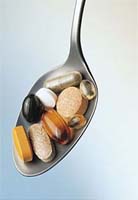Vitamins are normally associated with what the body finds difficult to produce on its own. These substances are important for a number of bodily functions and are required in small dosages.
So for our own knowledge we can break vitamins down into ‘vital minimums’.
In total thirteen vitamins have been identified and are listed as follows:
| Vitamin C | Vitamin B1 (Thiamin) | Niacin |
| Riboflavin | Vitamin B6 | Folic Acid (Folacin) |
| Vitamin B12 (Cobalamin) | Vitamin A | Vitamin D |
| Vitamin E | Vitamin K | Biotin |
| Pantothenic Acid |
Vitamins can be divided into two groups: the fat-soluble and water-soluble:
 Fat-soluble vitamins Include A, D, E, and K stored in body fat, principally in the liver. High dosages can be toxic, because the body is unable to rid excess amounts. Too much vitamins A and D can have cause serious adverse side effects.
Fat-soluble vitamins Include A, D, E, and K stored in body fat, principally in the liver. High dosages can be toxic, because the body is unable to rid excess amounts. Too much vitamins A and D can have cause serious adverse side effects.
Too much vitamin A can result in: loss of appetite, headaches, irritability, liver damage, bone pain, and neurological problems, including brain damage
While vitamin A is only found in animals, dark orange-yellow and green leafy vegetables contain carotenes (beta-carotene) that the body can use to make vitamin A. Unlike vitamin A, carotene is fairly safe when consumed in large amounts because the body stores excess carotenes (which can make the skin look yellow-orange) rather than converting them into vitamin A.
An excess of vitamin D can cause weight loss, vomiting, irritability, destructive deposits of calcium in soft tissues (such as the kidneys and lungs) and potentially fatal kidney failure.
Water soluble vitamins
Include vitamin C, vitamin B1 (thiamin), niacin, riboflavin, B6, B12, pantothenic acid, biotin, folic acid.
These are not stored in the body and need to be replaced daily.
Excess eliminated in the urine
Can be toxic with high dosages.
Consuming excess amounts of water-soluble vitamins can cause dangerous side effects:
Large amounts of niacin can cause severe flushing, skin disorders, liver damage, ulcers, and blood sugar disorders, interfere with fat metabolism and speed up glycogen depletion
Large doses of vitamin C have been associated with diarrhea, kidney stone formation, and impaired copper absorption [ see the further article on Vit C ]
An excess in vitamin B6 can result in neurological symptoms similar to multiple sclerosis, including numbness and tingling of the hands, difficulty in walking, as well as electric shocks shooting down the spine.
Vitamins assist in the processes of energy production, growth, maintenance, and repair. By keeping the body working properly, vitamins help to maintain health as well as proper growth and development in younger persons. Vitamins also assist in producing red blood cells, clotting blood, and maintaining vision.Vitamins do not: Prevent or cure any disease (including the common cold), except those related to specific vitamin deficiencies. Provide energy. Help children mature faster or become stronger, or enhance athletic performance.
In order to ensure that one gets sufficient vitamins make sure you are eating a healthy, well-balanced diet that includes the foods and servings recommended in the Food Guide Pyramid.
In order to insure that you are getting sufficient vitamins eat foods dense in nutrients such as grain products, fruits vegetables, and legumes. Avoid high-sugar and high in fat snacks. optimal nutrition
Athletes should never limit their calorie intake as you run the risk of creating nutritional deficiencies. In such circumstances a vitamin/mineral supplement supplying 100% of the RDA or AI is recommended.
Those who are vegetarians or who absorption problems should consider a one-a-day multivitamin and multi-mineral (100% of the RDA) in order to ensure adequate intake of micronutrients.
If you do decide to take a vitamin supplement, make sure the product you select is well known and has been through the stringent testing to meet the necessary standards.
Most known manufacturers are more likely to make their products under tight manufacturing controls.





























